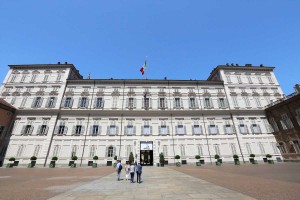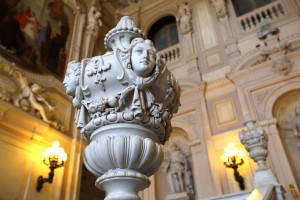
©Bigstock.com/mary416
1997 was a great year for Italy from a World Heritage Site perspective. A whopping ten new entries managed to get onto the illustrious UNESCO list. One of them even consists of an unbelievable 14 sites, all in Piedmont with focus on Turin. The residences of the Royal House of Savoy evoke the memory of a time of great power, fairy-tale-like life on the royal court and ostentatious splendour. Mighty palaces and imposing residences serve as a symbol unfathomable wealth and political influence, the latter even leading to the unification of Italy in later years. If you’d like to learn more about these 14 palaces, residences and villas, you’ve certainly come to the right place!
About the Savoyards
Let’s take a look at the fascinating history of the Royal House of Savoy, which had ruled over parts of France and Italy for over 900 years, before diving into the residences themselves. Humbert I Biancamano founded this royal house, having received the territory of Savoy and other counties around today’s French-Italian border through mere diplomatic skill. Ruling over three important mountain passes in the Alps, successive rulers gradually extended their influence. Skilful matrimonial policy lead to the incorporation of most of today’s Piedmont and parts of Liguria into the Savoyard counties as early as 1046.
The royal house saw its first major heyday in the early 14th century during the long reign of Amadeus VIII, who managed to realign the boundaries of his realm through gradual expansion. The Royal House of Savoy eventually transferred its centre of political power to the Piedmont after the Italian Wars. Most of the residences, which are now UNESCO World Heritage Site, were constructed, rebuilt or reclaimed during the 17th and 18th century. The Savoyards survived hegemony conflicts with the French, turned into the Kingdom of Sardinia and furthered the unification of Italy. The royal house managed state affairs until the deposition of Umberto II on 18 June 1946. His successors were only allowed to return to Italy in 2002.
Turin’s residences

©Bigstock.com/mary416
Having relocated the capital to Turin in 1562, Duke Emanuel Philibert of Savoy started to reshape the city and the surrounding Piedmont. Turin’s look was altered step by step leading to the installation of new magnificent buildings that attract tourists from all over the world to this very day. Five of the 14 residences included on the UNESCO list can be found directly in Turin. Let’s take a closer look at them:
- Palazzo Reale: We start our journey in the Royal Palace, built for Duchess Christine Marie of France, who assumed regency over Savoy after the death of her husband Victor Amadeus I. Palazzo Reale remained the palace of rulers and kings until 1865. The ostentatious building includes a direct entrance to the Chapel of the Holy Shroud.
- Palazzo Madama: Built on the grounds of an ancient Roman town, its former town gate was incorporated into the palace. Extended and reconstructed several times to become a prestigious city palace, the fully restored Palazzo Madama, now a cornerstone of historism, is currently used as an art museum.
- Palazzo Carignano: As the name suggests, this used to be the residence of the eponymous Princes of Carignano, a branch of the Royal House of Savoy. You will certainly notice the fascinating difference between the brick façade on the west side and the white, eclectic look on the east side. The former assembly building of the Subalpine Senate now houses a variety of institutions, such as the Risorgimento Museum.
- Castello del Valentino: The residence in Parco del Valentino had been serving as a nobility residence for centuries before being purchased by the Savoyards. Extensive structural alterations evoked the contemporary style of French architecture giving today’s seat of the Architecture Faculty of the Polytechnic University of Turin its present look.
- Villa della Regina: Victor Amadeus I had this city palace built for his brother, Prince-Cardinal Maurice of Savoy, in the early 17th The eventual “Villa of the Queen” showcases fairly unusual art. Numerous grotesques and uncommon frescoes can be found throughout this publicly accessible building, which was heavily damaged during the Second World War.
Other Savoyard residences in the Piedmont
A group of hunting and summer residences, the so-called “Corone delle Delizie”, can be found around Turin. These retreats for the Royal House of Savoy saw many a lavish celebration, became headquarters of avid art collectors and gave the royal court several locations for summer getaways. The following nine Savoyard residences were also declared UNESCO World Heritage Site:
- Palazzina di Stupinigi: Our first stop leads you to Nichelino, approx. 10 km southwest of Turin. The baroque hunting castle of Stupinigi was originally intended to be small but beautiful yet got expanded almost immediately upon completion per request of Duke Victor Amadeus II. You will certainly be amazed by the deceptively real-looking architectural painting.
- Reggia di Veneria Reale: The compound of Italy’s second-largest castle includes a special village for all personnel, a castle park (approx. 60 ha) and the former royal hunting ground, which has since become a zoo / nature park (approx. 300 ha). Massive galleries with elaborate stucco ornaments and the impressive chapel of St. Hubertus, the patron saint of hunters, should be part of your itinerary.
- Castello della Mandria: Situated in the heart of the second-largest enclosed park in Europe, Victor Amadeus II had an entire village converted into this very castle. You can find remnants of what used to be a huge forest in the park, while the castle itself impresses with a plurality of styles.
- Castello di Rivoli: Originally built on ancient walls, this castle in Rivoli became property of the Royal House of Savoy as early as 1280. Having been severely damaged by French troops in the late 17th century, it would take until 1984 before the Castello was completely rebuilt. It now houses a large museum of contemporary art.
- Castello di Agliè: Another Savoyard summer residence had been owned by various dukes since the 12th century before being almost destroyed during the invasion of French troops. Charles Emmanuel III had it completely renovated and turned into a summer residence for the Kings of Sardinia. More than 300 lavishly furnished rooms grace the castle surrounded by an enormous garden.
- Castello di Moncalieri: Thomas I of Savoy had first military structures added to a hill in Moncalieri as early as 1100. Those structures were extended and turned into a pleasure castle, site of many a Savoyard wedding, around 300 years later. The two cylindrical towers managed to capture the essence of the original medieval building.
- Castello di Racconigi: This royal castle only became UNESCO World Heritage Site in 2008. Its heterogenous look gives the palace of a Savoyard a branch a fairly unorthodox appearance, yet it has a distinctive allure to it due to its mix of medieval remnants and neoclassical aspects.
- Castello di Pollenzo: The 19th century saw this palace’s feudal and Renaissance roots converted into a rather wild clash of styles. Charles Albert, King of Sardinia-Piedmont, had the medieval structure extended for various festivities. Nowadays, the palace is privately owned and, sadly, cannot be visited.
- Castello di Govone: The final UNESCO World Heritage Site of the Royal House of Savoy is located in the heart of a wide vineyard. Like many other castles in the surroundings of Turin, the one in Govone also originally served as a medieval fortification before being turned into a summer residence during the 19th Fascinating statues await you at all corners.
To this very day the residences of the Royal House of Savoy attest to Turin’s former central role in the European power game. The transport nodal point in Northern Italy impresses with architectural variety, imposing opulence and close-to-nature subtlety. Retrace the steps of the Savoyards and plan your next holiday in Italy with ZAINOO!